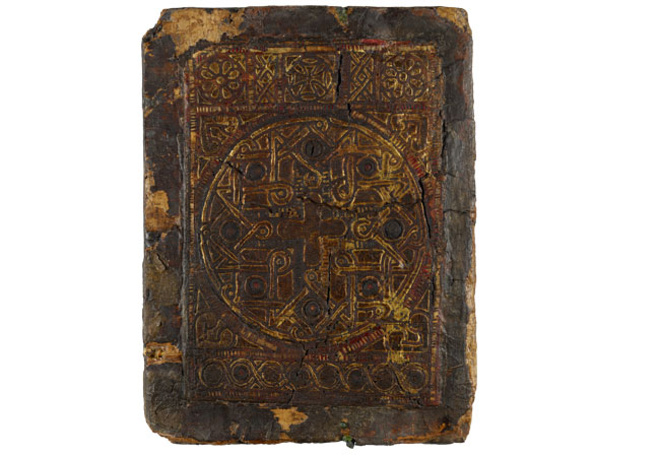From the Exhibition:
The Codex and Crafts of Late Antiquity
The aesthetic and technical highlight of the Coptic bookbinding collection at the Morgan Library and Museum is the upper cover of manuscript M.569. Discovered in a cistern in 1910 near the village of Hamuli, Egypt, the binding originally covered a manuscript of the Four Gospels, the only copy of the Four Gospels of the fifty or so manuscripts in the Hamuli find. The collection of manuscripts constitutes the entire library of the Coptic monastery of St. Michael of the Desert, for which there was no known record until this discovery. The manuscript, which dates between AD 822 and 914, was written on parchment and covered with decorated leather over papyrus boards. The cover boards are attached to the manuscript with bridling at five sewing stations, which are visible on the left side. Endbands were sewn at head and tail. The covers were held together at head, tail, and fore-edge with the use of a loop-and-peg technique. Seven bronze or bone pegs were inserted into the lower board, three at the fore-edge and two each at head and tail. Plaited leather loops anchored around the upper board would have attached to the pegs to keep the parchment text block, or book block as it is termed in the exhibition, secure.
The decorative technique is elaborate and complicated. The cover is composed of layers of gilt leather, parchment, and cut openwork red leather colored with a transparent organic red dye. The red leather cutwork, or tracery, is interwoven with strips of parchment and sewn to a layer of leather covered with gold leaf, which creates a radiant background for the design elements of the cutwork. The gold leaf is applied in a series of squares; the perimeter of the gold leaf squares is still visible on the cover. The design consists of a circular decoration within a square. A central cross is surrounded by a variety of motifs, including heart-shaped decorations, an eight-pointed cross, floral designs, and geometric shapes. Concentric circles of colored leather throughout the design, especially at the four corners of the central cross, convey a sense of depth to the decoration. The circles consist of dark and light brown leather with a center of red leather. The same technique of red cutwork leather over a gilt leather background can be found on an ex libris on the inside of the front cover, as well as on the back cover (fig. 1).

The ex libris reads “the Archangel Michael.” A colophon in the manuscript indicates that the codex previously belonged to the monastery of Mary Mother of God of Perkethoout, a village near the monastery of St. Michael.
Dating the cutwork design of the Four Gospels is complex. The technique is similar to patterns found on Coptic footwear and on a Coptic red leather binding now in the National Library of Vienna, both of which date to the sixth or seventh century. A possible history of the manuscript and binding is that it was written for the monastery in Perkethoout, transferred to the monastery of St. Michael, embellished with a decorative panel of leather tracery that predates the manuscript by a century, and identified by an ex libris made using a similar pattern as the original decorative technique. The attempt to unwind the history of the binding of MS M.569 reveals a web of aesthetic relationships between religious communities and artisanal practices that describe an identifiable Coptic tradition over time.
Francisco H. Trujillo is Associate Book Conservator at the Morgan Library and Museum.












